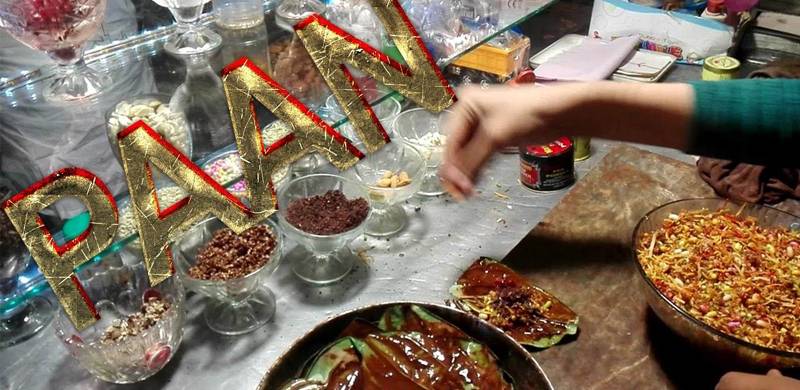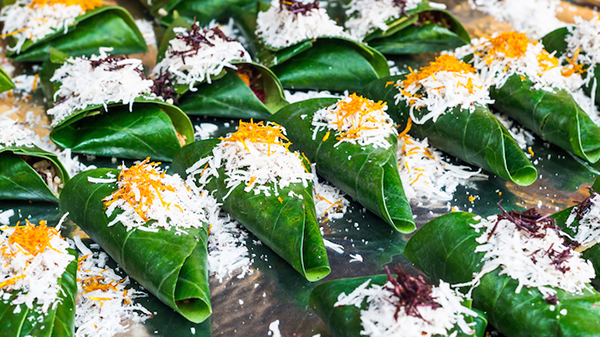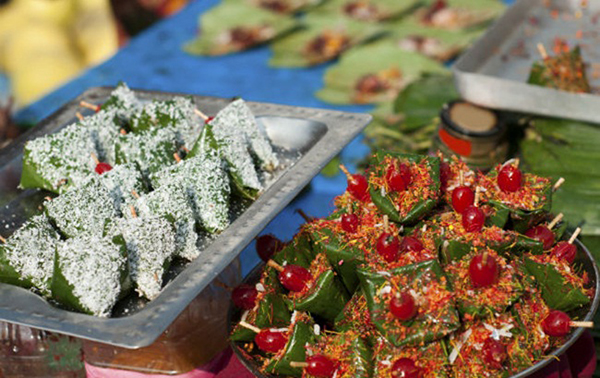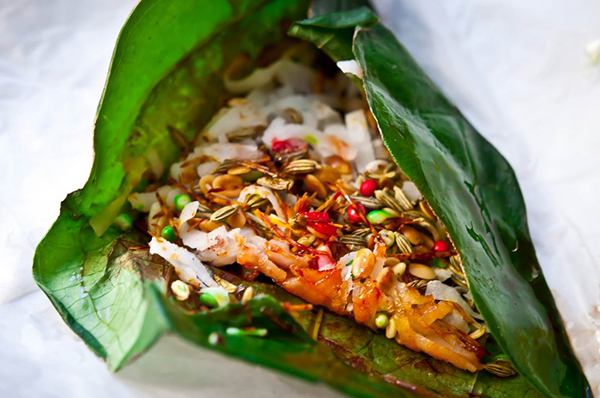
LAHORE - One could hardly find a reason behind price increase of tomatoes in Pakistan after the Pulwama incident. But, traders in Lahore’s paan markets provide enough justification for sharp rise in the rates of betel leaves during days of Pakistan-India standoff.
Two reasons: Pakistan is among top five dairy producers in the world and hence people have enough yogurt as an alternative to tomatoes while cooking.
However, thousands of paan eaters of Lahore are really left with no option when betel leaf disappears from market as a result of tensions between Islamabad and New Delhi.
https://www.youtube.com/watch?v=XprXbXDMVOQ
Paan is a preparation combining betel leaf with areca nut, slaked lime (chunna), katha and tobacco. And among all these things used to prepare a paan, only betel leaves require fresh supplies from the neighbor.
Samjhota Express is perhaps the most viable medium to deliver the leaves in Lahore.
But, supply is badly affected when the bi-weekly friendship train between Lahore and New Delhi halts its operation due to tensions between the two countries. And it results in black marketing, price increase and in many cases complete disappearance of leaves from the market.
“Shukar hay Modi paan pata permanent band krnay ki dhamkey nhe deta, [Thank God Modi doesn’t issue threats to stop permanent supply of betel leaf to Pakistan],” a lively Lahori young man, Naveed Anwar who chews paan for years and runs a pizza shop at city’s famous Mall Road, winked, apparently referring to Indian premier rhetoric about stopping flow of waters from western rivers to Pakistan.

Paan chewing or eating for stimulation, fun or activity is a centuries-old tradition, custom, ritual in India. Many trace its link with Rajput warriors’ bravery in battlefields and some find its root in rich classical music of subcontinent.
Paan eating habit largely entered into Pakistan after 1947, though people in Karachi and interior Sindh were already fond of it.
Those who migrated from Delhi, Agra, Lucknow, Bombay and other parts of central, northern and southern India to the newly founded country also brought with them this culture. Those people were called Muhajirs (migrants) in Pakistan.
Presenting paan to guests was considered a symbol of respect among Muhajir families. No matter what was their approach towards religion and state, paan was loved equally of Islamic scholar Shah Ahmad Noorani and liberal revolutionary poets like Josh Malihabadi and Jaun Elia. And they all were migrants.
Many Pakistanis proudly link their skill of paan preparation to that made in Banaras. The Paan of Banaras (now Varanasi) is considered superior and perfect and one could find the strong nostalgic feelings of Shehnai-master late Ustad Bismillah Khan about Banarasi paan in his old TV interview.

Paan took few years to get popularity in Pakistan after 1947 and now there are millions of its eaters across the country. From a tradition, culture or custom, it turned into an industry of billions of rupees in Pakistan.
In Lahore, a city of more than 10 million people, many thousands eat paan. The Paan Mandi in old Anarkali and Railway Station Market are city’s two main paan trade centres.
“Believe me, betel leaves started disappearing from markets after Pulwama incident and they completely vanished from Lahore after airstrikes episode,” said Ghulam Rasool, who runs Shehansha Paan Shop in Thokar Niaz Baig area of the city.
“I go to a friend who arranges one kg leaves for me from somewhere these days.”
Usually, he said, per kg rate is Rs2,000 but now it touches Rs4,000. People say supply from India will resume in next couple of days, he hoped.
Paan is prepared combining betel leaf with areca nut. However, since the introduction of tobacco from the Western Hemisphere to the Eastern Hemisphere, it has been an optional addition to paan.

Over 90 percent of people in India and Pakistan now eat the paan made of tobacco with the addition of slaked lime and katha paste which is added to bind the leaf. Katha/Catechu is an extract of acacia trees. People boil tree wood and then mix milk into it to prepare the katha which is used in paan.
Ghulam Rasool says katha, nuts, tobacco, and everything remains available in market but only leaves disappear when something goes wrong between two countries. And everyone knows that a paan is not a paan without the leaf, he adds. His shop is full of tobacco boxes (Raja Jani, Dilbar, Najma, Guru, 300 Ratna, Raj, Insaaf, Banarsi), katha, a chuna but with few leaves. A per kg bundle has almost 300 paan leaves, according to Ghulam Rasool. The price of one paan varies between Rs20 to Rs30 depending on quality of tobacco.
Paan, according to historians, spread to the Indo-Pacific during prehistoric times, reaching Near Oceania at 3,500 to 3,000 BP; South India and Sri Lanka by 3,500 BP; Mainland Southeast Asia by 3,000 to 2,500 BP; Northern India by 500 BP; and Madagascar by 600 BP.
From India, they claim, it was also spread westwards to Persia and the Mediterranean. Ibn Battuta (1304-1368), a Muslim Moroccan scholar and explorer, described the paan eating practice in India as follows: "The betel is a tree which is cultivated in the same manner as the grape-vine; ... The betel has no fruit and is grown only for the sake of its leaves ... The manner of its use is that before eating it one takes areca nut; this is like a nutmeg but is broken up until it is reduced to small pellets, and one places these in his mouth and chews them. Then he takes the leaves of betel, puts a little chalk on them, and masticates them along with the betel.”
Medics say paan eating is a bad addiction and may cause oral cancer but Lahoris say, war is the real cancer.
Two reasons: Pakistan is among top five dairy producers in the world and hence people have enough yogurt as an alternative to tomatoes while cooking.
However, thousands of paan eaters of Lahore are really left with no option when betel leaf disappears from market as a result of tensions between Islamabad and New Delhi.
https://www.youtube.com/watch?v=XprXbXDMVOQ
Paan is a preparation combining betel leaf with areca nut, slaked lime (chunna), katha and tobacco. And among all these things used to prepare a paan, only betel leaves require fresh supplies from the neighbor.
Samjhota Express is perhaps the most viable medium to deliver the leaves in Lahore.
But, supply is badly affected when the bi-weekly friendship train between Lahore and New Delhi halts its operation due to tensions between the two countries. And it results in black marketing, price increase and in many cases complete disappearance of leaves from the market.
“Shukar hay Modi paan pata permanent band krnay ki dhamkey nhe deta, [Thank God Modi doesn’t issue threats to stop permanent supply of betel leaf to Pakistan],” a lively Lahori young man, Naveed Anwar who chews paan for years and runs a pizza shop at city’s famous Mall Road, winked, apparently referring to Indian premier rhetoric about stopping flow of waters from western rivers to Pakistan.

Paan chewing or eating for stimulation, fun or activity is a centuries-old tradition, custom, ritual in India. Many trace its link with Rajput warriors’ bravery in battlefields and some find its root in rich classical music of subcontinent.
Paan eating habit largely entered into Pakistan after 1947, though people in Karachi and interior Sindh were already fond of it.
Those who migrated from Delhi, Agra, Lucknow, Bombay and other parts of central, northern and southern India to the newly founded country also brought with them this culture. Those people were called Muhajirs (migrants) in Pakistan.
Presenting paan to guests was considered a symbol of respect among Muhajir families. No matter what was their approach towards religion and state, paan was loved equally of Islamic scholar Shah Ahmad Noorani and liberal revolutionary poets like Josh Malihabadi and Jaun Elia. And they all were migrants.
Many Pakistanis proudly link their skill of paan preparation to that made in Banaras. The Paan of Banaras (now Varanasi) is considered superior and perfect and one could find the strong nostalgic feelings of Shehnai-master late Ustad Bismillah Khan about Banarasi paan in his old TV interview.

Paan took few years to get popularity in Pakistan after 1947 and now there are millions of its eaters across the country. From a tradition, culture or custom, it turned into an industry of billions of rupees in Pakistan.
In Lahore, a city of more than 10 million people, many thousands eat paan. The Paan Mandi in old Anarkali and Railway Station Market are city’s two main paan trade centres.
“Believe me, betel leaves started disappearing from markets after Pulwama incident and they completely vanished from Lahore after airstrikes episode,” said Ghulam Rasool, who runs Shehansha Paan Shop in Thokar Niaz Baig area of the city.
“I go to a friend who arranges one kg leaves for me from somewhere these days.”
Usually, he said, per kg rate is Rs2,000 but now it touches Rs4,000. People say supply from India will resume in next couple of days, he hoped.
Paan is prepared combining betel leaf with areca nut. However, since the introduction of tobacco from the Western Hemisphere to the Eastern Hemisphere, it has been an optional addition to paan.

Over 90 percent of people in India and Pakistan now eat the paan made of tobacco with the addition of slaked lime and katha paste which is added to bind the leaf. Katha/Catechu is an extract of acacia trees. People boil tree wood and then mix milk into it to prepare the katha which is used in paan.
Ghulam Rasool says katha, nuts, tobacco, and everything remains available in market but only leaves disappear when something goes wrong between two countries. And everyone knows that a paan is not a paan without the leaf, he adds. His shop is full of tobacco boxes (Raja Jani, Dilbar, Najma, Guru, 300 Ratna, Raj, Insaaf, Banarsi), katha, a chuna but with few leaves. A per kg bundle has almost 300 paan leaves, according to Ghulam Rasool. The price of one paan varies between Rs20 to Rs30 depending on quality of tobacco.
Paan, according to historians, spread to the Indo-Pacific during prehistoric times, reaching Near Oceania at 3,500 to 3,000 BP; South India and Sri Lanka by 3,500 BP; Mainland Southeast Asia by 3,000 to 2,500 BP; Northern India by 500 BP; and Madagascar by 600 BP.
From India, they claim, it was also spread westwards to Persia and the Mediterranean. Ibn Battuta (1304-1368), a Muslim Moroccan scholar and explorer, described the paan eating practice in India as follows: "The betel is a tree which is cultivated in the same manner as the grape-vine; ... The betel has no fruit and is grown only for the sake of its leaves ... The manner of its use is that before eating it one takes areca nut; this is like a nutmeg but is broken up until it is reduced to small pellets, and one places these in his mouth and chews them. Then he takes the leaves of betel, puts a little chalk on them, and masticates them along with the betel.”
Medics say paan eating is a bad addiction and may cause oral cancer but Lahoris say, war is the real cancer.
